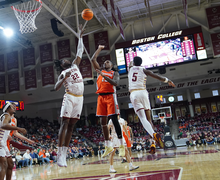Syracuse’s interior defenders struggle to contain versatile forwards
Corey Henry | Staff Photographer
Syracuse guard Gabrielle Cooper battles for a rebound in Syracuse's win over Pitt earlier this season.
Syracuse head coach Quentin Hillsman waved his arms above his head and begged for his defense to get a stop. Notre Dame ran fast, but in the first quarter of Syracuse’s Feb. 25 matchup, SU kept up. It forced turnovers, rebounded on misses under the basket and pushed the other way.
But the Fighting Irish kept firing, they kept running. They scored one bucket, then another, then another. As the 3-pointers started to fall, the inside opened up. Syracuse’s bigs were no match for the Irish. The Orange had long run a press to force turnovers and push transition, but in the second quarter they fell back, and defensive holes were exploited. As the game grew out of reach, Hillsman’s hands fell to his side. Missed assignments, poor switches and late reactions were too much. He put his hands to his knees.
“You have a chance on your home floor playing against one of the best teams in the country, and we know that they’re a very good basketball team, I really feel that we’re a very good basketball team,” Hillsman said postgame. “But to come on the floor and perform this way is very disappointing.”
No. 12 Syracuse (24-8, 11-5 Atlantic Coast) has struggled with its interior defense the entire season. Against strong forward units, the Orange have shown an inability to stay in front of offensive players in the post and from the elbow, frequently falling to a quick first step to the basket. SU’s best blocker, Emily Engstler, ranks just 130th in the nation with 1.30 per game. Hillsman frequently references the unit’s youth as a main factor of the struggles, but inside defense is a holistic effort. Penetration and passes inside the arc past guards have allowed opponents to take advantage of the Orange, he said.

Anna Henderson | Digital Design Editor
The Orange, who earned a No. 3 seed in the NCAA Tournament, drew a first round matchup with No. 14 Fordham on Saturday in the Carrier Dome. The Rams rely mainly on their backcourt with three guards in their top-four scorers, but forward Mary Goulding has provided a consistent presence down low with 12.9 points per game. Though Fordham might not provide a prevalent interior challenge, the Orange’s paint defense has dictated their ability to take control of games and will be an important piece for Syracuse in the NCAA Tournament.
At the end of each practice, Syracuse runs a defensive slides drill. Associate head coach Vonn Read starts while defenders position themselves in the Orange’s 2-3 zone. Read passes the ball to the lead guard who swings it to a wing player. After the pass, defenders rotate into new spots. The strong side player at the top of the zone rotates to the ball, and the weak side player minds the elbow. The strong side player at the bottom of the zone denies on the wing, and the center of the zone fills the spot they left while the weak side player minds the basket.
The rotation allows defenders to practice their assignment-based shifts dependent on ball-movement. The flow is sometimes broken by quick passing, though, like when the Orange were broken down against Notre Dame’s dangerous perimeter attack. Other problems have sometimes persisted in standstill sets.
In two matchups with Miami this season, Emese Hof and Beatrice Mompremier combined for 85 points and 32 rebounds on the interior. Both players operate mainly on straight-line drives from the elbow. In the ACC Tournament, Mompremier scored multiple baskets in a row by drawing an SU defender to the free throw line and using one dribble to blow past them to a wide-open rim. Unlike the drill the Orange frequently practice, the weak side defender is often late.
Versatile forwards have given Syracuse trouble multiple times this season and have allowed an average 35.25 points in the paint in its losses. Against Miami, Hof and Mompremier easily found openings. And in their biggest loss, the Irish used the Orange’s struggles on the interior to their advantage, UND head coach Muffet McGraw said. They began the game with a “high-low” attack in an attempt to “suck in” the Syracuse zone, freeing space for their perimeter attack. That’s exactly what the Orange did, and their shortcomings lessened their presence around the 3-point line.
“I think it was just a credit to our post,” Notre Dame guard Arike Ogunbowale said. “They have a good inside-out game, they’re able to find the guards on the perimeter.”
Its zone collapsed, its transition defense struggled, its shots didn’t fall. Though shooting slumps have hurt the Orange this season, Read said SU doesn’t need to shoot a high percentage to win games. But, as a part of its margin-based system, when opponents find the openings it has inside, Syracuse is left without a chance to battle back.
Published on March 19, 2019 at 10:52 pm
Contact Michael: mmcclear@syr.edu | @MikeJMcCleary






